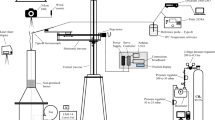Abstract
Compact flame-holders for afterburners are an increasing requirement for modern aero engines. However, flame-holder design is non-trivial since high inlet temperatures, velocities, and elaborate structures induce complex turbulence, combustion, and spray coupling in modern afterburners. In this work, the LES-pdf and stochastic fields-Lagrangian particle spray methods are used to investigate methane and aviation kerosene combustion structures formed by new-type concave flame-holders. The flow pattern, combustion mode, and flame structure of gaseous and liquid fuel around a concave flame-holder are analyzed, discussed, and compared with experimental results. Results reveal that the flame stability of a concave flame-holder is better than that of the non-concave one. Furthermore, when using liquid fuel, the concave flame-holder forms a stable and compact flame. These results suggest concave flame-holders are a promising design for compact afterburners.
Similar content being viewed by others
Abbreviations
- e ij :
-
strain tensor
- G :
-
normalized filter function
- n :
-
number of droplets contained within the finite volume cell (for source terms equation)
- p :
-
static pressure
- \(\overline{\dot{S}}_{\text{mass}}\) :
-
contribution of dispersed phase as sources of mass
- \(\overline{\dot{S}}_{\text{mom},i}\) :
-
contribution of dispersed phase as sources of momentum in ith direction
- S (p) :
-
source term arising from the pth droplet
- u j :
-
gas phase velocity
- \(\xi_{\alpha}^{n}(x,t)\) :
-
nth scalars of αth stochastic field
- ρ g :
-
density of the gaseous phase
- σ :
-
Prandtl number (for energy equation) or Schmidt number (for species equation)
- ϕ α :
-
the αth scalar field
- Ω :
-
integration domain
References
Sun Y., Zhang Z., Li J., et al., Design and numerical research of integrated rear frame and afterburner. Journal of Aeronautical Science and Technology, 2011, 4: 71–74. (in Chinese)
Wadia A.R., James F.D., F110-GE-129 EFE—enhanced power through low-risk derivative technology. Turbo Expo: Power for Land, Sea, and Air, Volume 1: Aircraft Engine; Marine; Turbomachinery; Microturbines and Small Turbomachinery. Munich, Germany. May 8–11, 2000. V001T01A019. ASME. DOI: https://doi.org/10.1115/2000-GT-0578.
Liang C., Yang D., Liu H., Present and future development of advanced second burner for aeroengine. Journal of Aeroengine, 2012, 38(5): 1–5.
Zhang X., Sun Y., Liu T., Summary of advanced afterburner design technology. Journal of Aeroengine, 2014, 40(2): 24–30.
Han M., Xu Q., Han X., et al., Dynamics of stratified swirl flame near lean blow out. Propulsion and Power Research, 2021, 10(3): 235–246.
Ayed A.H., Kusterer K., Funke H.W., et al., Experimental and numerical investigations of the dry-low-NOx hydrogen micromix combustion chamber of an industrial gas turbine. Propulsion and Power Research, 2015, 4(3): 123–131.
Jones W.P., Navarro-Martinez S., Study of hydrogen auto-ignition in a turbulent air co-flow using a large eddy simulation approach. Computers and Fluids, 2007, 37: 802–808.
Bini M., Jones W.P., Large eddy simulation of particle-laden turbulent flows. Journal of Fluid Mechanics, 2008, 614: 207–252.
Gong Y., Jones W.P., Marquis A.J., Study of a premixed turbulent counterflow flame with a large eddy simulation method. Flow, Turbulence and Combustion, 2021, 106(4): 1379–1398.
Jones W.P., Prasad V.N., Large eddy simulation of the Sandia flame series (d–f) using the eulerian stochastic field method. Combustion and Flame, 2010, 157(9): 1621–1636.
Popov P.P., Pope S.B., Large eddy simulation/probability density function simulations of bluff body stabilized flames. Combustion and Flame, 2014, 161(12): 3100–3133.
Jones W.P., Marquis A.J., Wang F., Large eddy simulation of a premixed propane turbulent bluff body flame using the Eulerian stochastic field method. Fuel, 2015, 140: 514–525.
Hodzic E., Jangi M., Szasz R.Z., et al., Large eddy simulation of bluff body flames close to blow-off using an Eulerian stochastic field method. Combustion and Flame, 2017, 181: 1–15.
Brauner T., Jones W.P., Marquis A.J., LES of the Cambridge stratified swirl burner using a sub-grid pdf approach. Flow, Turbulence and Combustion, 2016, 96(4): 965–985.
Jones W.P., Marquis A.J., Vogiatzaki K., Large-eddy simulation of spray combustion in a gas turbine combustor. Combustion and Flame, 2014, 161(1): 222–239.
Gallot-Lavallee S., Jones W.P., Marquis A.J., Large eddy simulation of an ethanol spray flame with secondary droplet breakup. Flow, Turbulence and Combustion, 2021, 107(3): 709–743.
Gardiner C.W., Handbook of stochastic methods. For Physics, Chemistry and the Natural Science, volume 13 of Springer Series Synergetics. Springer, 1983.
Jones W.P., Lindstedt R.P., Global reaction schemes for hydrocarbon combustion. Combustion and Flame, 1988, 73(3): 233–249.
Vukadinovic V., Habisreuther P., Zarzalis N., Influence of pressure and temperature on laminar burning velocity and markstein number of kerosene jet a-1: Experimental and numerical study. Fuel, 2013, 111: 401–410.
Jones W.P., Kerosene kinetics. Personal Communication, November 2018.
Wang H., Design and research on new-type flame stabilizer. Technical report, Beihang University, Beijing, China, 2012.
Zhang R., Liu Y., Xie Y., Effects of fuel injection on flame propagation of cavity-based strut flame-holder. Journal of Propulsion Technology, 2017, 38(9): 2046–2054.
Ranz W., Marshall W., Evaporation from drops - part (i) and part (ii). Chemical Engineering Progress, 1952, pp. 141–146, 173–180.
Liu G., Liu Y., Xie Y., Effect of cavity on combustion characteristics of integrated strut flame stabilizer. Journal of Aerospace Power, 2018, 33(8): 1838–1844.
Wang F., Liu R., Dou L., et al., A dual timescale model for micro-mixing and its application in LES-TPDF simulations of turbulent nonpremixed flames. Chinese Journal of Aeronautics, 2019, 32(4): 875–887.
Acknowledgments
National Science and Technology Major Project (2017-I-0004-0005) and National Natural Science Foundation of China (91741125).
Author information
Authors and Affiliations
Corresponding author
Ethics declarations
On behalf of all authors, the corresponding author states that there is no conflict of interest.
Rights and permissions
About this article
Cite this article
Wang, F., Wang, Y., Wei, G. et al. Flame Structure of Methane and Kerosene Combustion with A Compact Concave Flame-Holder using the LES-pdf Method. J. Therm. Sci. 33, 222–234 (2024). https://doi.org/10.1007/s11630-023-1898-4
Received:
Published:
Issue Date:
DOI: https://doi.org/10.1007/s11630-023-1898-4



